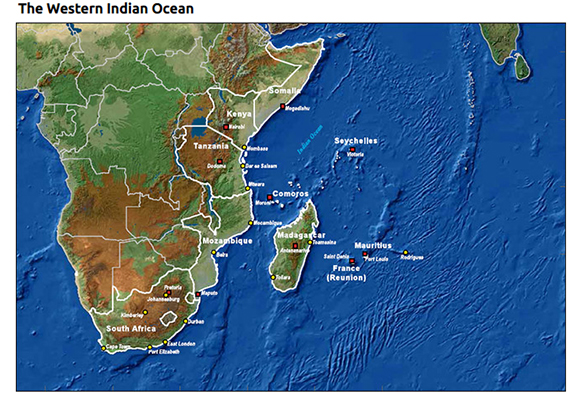Internal Security
Exercise Cutlass Express
- 27 Jul 2021
- 6 min read
Why in News
Recently, Indian Naval Ship Talwar participated in a multinational training exercise Cutlass Express 2021, being conducted along the East Coast of Africa.
Key Points
- About Exercise Cutlass Express:
- The exercise is an annual maritime exercise conducted to promote national and regional maritime security in East Africa and the Western Indian Ocean.
- The 2021 edition of the exercise involves participation of 12 Eastern African countries, US, UK, India and various international organisations like International Maritime Organisation (IMO), United Nations Office on Drugs and Crime (UNODC), Interpol, European Union Naval Force (EUNAVFOR), Critical Maritime Routes Indian Ocean (CRIMARIO).
- The exercise is designed to assess and improve combined maritime law enforcement capacity, promote national and regional security and increase interoperability between the regional navies.
- India’s Information Fusion Centre – Indian Ocean Region (IFC-IOR) is also participating in the exercise.
- India’s participation is in accordance with India's stated policy towards maritime cooperation in the Indian Ocean region and vision SAGAR (Security and Growth for All in the Region).
- Significance of Western Indian Ocean:
- The Western Indian Ocean is where the Indian Ocean and Arabian Sea meet. It connects North America, Europe and Asia, and as such is of global strategic importance.
- The Western Indian Ocean (WIO) region comprises 10 countries: Somalia, Kenya, Tanzania, Mozambique, South Africa, Comoros, Madagascar, Seychelles, Mauritius, and the French overseas territory of Réunion.
- Its rich natural resource profile has pushed global players to view the region with increasing interest in recent years.
- India’s compulsions for energy security and its dependence on overseas resources has been the biggest pull drawing it closer to the region.
- Nature of Inter-regional Cooperation in WIO region:
- Programme to Promote Regional Maritime Security (MASE): The MASE Programme was adopted in 2010 in Mauritius, and is jointly run by the European Union (EU) and the United Nations Office on Drugs and Crime (UNODC).
- The programme’s primary objective is to strengthen the maritime security capacity of Eastern and Southern Africa and the WIO region in order to implement the Regional Strategy and Action Plan against Piracy.
- Indian Ocean Commission (IOC) is a part of it.
- Djibouti Code of Conduct (DCoC): It provides a framework for capacity building in the WIO region and Gulf of Aden in order to counter the threat of piracy.
- This is the first such code to be operational in the Western Indian Ocean waters. The code was signed in January 2009.
- Jeddah amendment to the Djibouti Code of Conduct (DCoC+): It was made in 2017 to cover other illicit maritime activities, including human trafficking and illegal, unreported and unregulated fishing and to build national and regional capacity to address wider maritime security issues, as a basis for sustainable development of the maritime sector.
- India has joined the Djibouti Code/Jeddah amendment.
- Indian Ocean Commission: The IOC is an intergovernmental organisation founded in 1982 comprises five small-island states in the Western Indian Ocean: the Comoros, Madagascar, Mauritius, Réunion (a French department), and Seychelles.
- India has been accepted as an observer of the IOC.
- Indian Ocean Rim Association: It was established in 1997 and is a regional forum that seeks to build and expand understanding and mutually beneficial cooperation through a consensus-based, evolutionary and non-intrusive approach.
- IORA has 22 member states, including Australia, Bangladesh, Comoros, India, Indonesia, Iran, Kenya, Madagascar, Malaysia, Maldives, Mauritius, Mozambique, Oman, Seychelles, Singapore, Somalia, South Africa, Sri Lanka, Tanzania, Thailand, UAE, and Yemen.
- Its Secretariat is based in Cyber City, Ebène, Mauritius.
- Programme to Promote Regional Maritime Security (MASE): The MASE Programme was adopted in 2010 in Mauritius, and is jointly run by the European Union (EU) and the United Nations Office on Drugs and Crime (UNODC).
INS Talwar
- INS Talwar is the lead ship of the Talwar-class frigates or Krivak class stealth ships of the Indian Navy.
- New Frigates: The Krivak class stealth ships are being built with technology transfer from Russia by Goa Shipyard Ltd. (GSL) under ‘Make in India’. Engines for the ships are supplied by Ukraine.
- In October 2016, India and Russia signed an Inter-Governmental Agreement (IGA) for four Krivak or Talwar stealth frigates.
- The first two frigates will be built in Yantar Shipyard, in Kaliningrad, Russia. The following two will be built in GSL.
- Existing Frigates: The navy already operates six Krivak III frigates.
- The new Krivak frigates that joined the fleet between April 2012 and June 2013 are INS Teg, Tarkash and Trikand.
- The first three that joined the fleet between June 2003 and April 2004, are INS Talwar, INS Trishul, INS Tabar.
- Use: They are primarily used to accomplish a wide variety of naval missions such as finding and eliminating enemy submarines and large surface ships.





